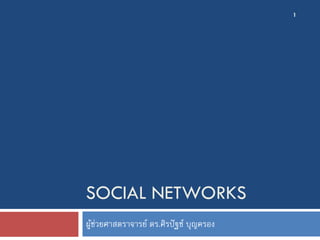
Introduction to Social Networks
- 1. 1 SOCIAL NETWORKS ผูช่วยศาสตราจารย์ ดร.ศิรปั ฐช์ บุญครอง ้
- 2. หัวข้อ 2 เครือข่ายสังคม แรงจูงใจ ประเภท ผลกระทบ แนวโน้มในอนาคต ตัวอย่างเครือข่ายสังคม Facebook Google+ เครือข่ายสังคมกับการทางานเป็ นทีม
- 3. เครือข่ายสังคม 3 วิวฒนาการ ั Web 1.0 Web 2.0 Source: blog.aysoon.com
- 4. เครือข่ายสังคม 4 การขยายตัวอย่างรวดเร็วของสังคมการสื่อสารแบบออนไลน์ได้สะท้อนให้ เห็นถึงความเปลี่ยนแปลงในระยะยาวของแนวโน้มการสื่อสารที่สาคัญใน 2 ด้าน รูปแบบการสื่อสาร (Communication Platform) การควบคุมการสื่อสาร (Communication Control)
- 6. รายงานการใช้งานอินเทอร์เน็ ตปี 2553 6 รูปแบบแอพพลิเคชันที่มีการใช้งาน Source: Internet User Profile of Thailand 2010 (NECTEC)
- 8. เครือข่ายสังคม คืออะไร 8 พจนานุ กรมฉบับราชบัณฑิตยสถาน พุทธศักราช 2525 อธิบายว่า สังคม คือ คนจานวนหนึ่ งที่มีความสัมพันธ์ต่อเนื่ องกันตามระเบียบกฎเกณฑ์ โดยมี วัตถุประสงค์สาคัญร่วมกัน Wikipedia บอกว่า สังคม เป็ นการอยูรวมกันของสิ่งมีชวต สังคมของมนุ ษย์ ่ ีิ เกิดจากกลุ่มบุคคลที่มีความสนใจร่วมกันไม่วาจะในด้านใด ่ สังคม คือ การที่กลุ่มคนกลุ่มหนึ่ งที่มีความสนใจในเรื่องเดียวกัน มา รวมกลุ่มกันในสถานที่ที่ตอบรับกับความสนใจของเขา และสร้าง ความสัมพันธ์อย่างต่อเนื่ อง
- 9. เครือข่ายสังคม คืออะไร 9 Social: A characteristic of living organisms The interaction of organisms with other organisms Attitudes or behaviours which take the interests or needs into account
- 10. Social Networking – 19th Century 10 Village Square – The Hub: Physiological needs Food, water, shelter Safety Employment, health Love Friendship, courtship, family Esteem Squire of village http://www.worldgallery.co.uk
- 11. Social Networking – 21st Century 11 Global Village Square – Social Media Sites: Physiological needs Food, water, shelter Safety Employment, health Love Friendship, courtship, family Esteem Blogs, social media
- 12. เครือข่ายสังคมออนไลน์ คืออะไร 12 Social Networks Social Media เครือข่ายสังคมที่เกิดขึ้ นบนอินเทอร์เน็ ต ชุมชมออนไลน์ (Online Community)
- 16. Social Network Services 16 Create user profile Create relationships Upload pictures Chat Share interests Games
- 17. ประเภทของ Social Networks 17 การเขียนบทความ (Weblog) แหล่งข้อมูลหรือความรู ้ (Data/ Knowledge) ประเภทเกมส์ออนไลน์ (Online games)
- 18. ประเภทของ Social Networks 18 ประเภทชุมชนออนไลน์ (Community) ประเภทฝากรูปภาพ (Photo management) ประเภทสื่อ (Media) เว็บที่ใช้ฝากหรือแบ่งปั น (Sharing) ประเภทซื้ อ-ขาย (Business / commerce)
- 19. ผลกระทบ 19 ผลกระทบด้านสังคม ผลกระทบด้านเศรษฐกิจ ผลกระทบด้านการเมือง
- 20. สถิติการใช้งาน 20 กลุ่มที่มีอายุอยูระหว่าง 6-10 ปี ่ นิ ยมที่จะใช้ Social Networking เพื่อเรียนรูเ้ รืองราวต่างๆ ด้วยตนเองผ่านเกมส์ ่ ออนไลน์ เช่น Ragnarok, Audition กลุ่มที่มีอายุระหว่าง 15-30 ปี เพื่อความบันเทิงและการติดต่อสื่อสาร ระหว่างกลุ่มเพื่อน เช่น เล่นเกมส์ Download เพลง ภาพ หรือวีดีโอต่างๆ อย่าง Hi5, Facebook, YouTube กลุ่มที่มีอายุระหว่าง 30-45 ปี ใช้ประโยชน์ ในการสืบค้นหาข้อมูลข่าวสาร ติดต่อสื่อสารกับลูกค้าโดยการใช้เป็ น เครื่องมือทางการสื่อสารการตลาด การค้นหาความรู ้ การอ่านข่าวสารประจาวัน เช่น Wikipedia, Google Earth, Twitter, Webblog, Website ของสานักข่าว ต่างๆ
- 21. สถิติการใช้งาน 21 65% ของผูใช้งาน Facebook มีอายุ 35 ปี หรือมากกว่า ้ อายุเฉลี่ยของผูใช้งาน Facebook คือ 40.5 ปี ้ อายุเฉลี่ยของผูใช้งาน Twitter คือ 37.3 ปี ้ Facebook และ Twitter มีอตราส่วนของผูใช้งานที่เป็ นเพศชายและหญิง ั ้ เท่ากัน คือ ชาย 40% และหญิง 60%
- 22. Social Media in Thailand 22
- 23. Social Media in Thailand 23
- 24. Social Media in Thailand 24
- 25. Social Media in Thailand 25
- 26. 26 Facebook
- 27. Facebook 27 “Facebook is an online directory that connects people through social networks …” “Facebook is a social utility that connects people with friends and others who work, study and live around them” Founded in February 2004 Mark Zuckerberg Eduardo Saverin Dustin Moskovitz Chris Hughes
- 28. ผูใช้งาน Facebook ทัวโลก ้ ่ 28
- 29. Facebook 29 http://www.socialbakers.com/facebook-statistics/
- 30. Facebook 30
- 31. Components of Facebook 31 Friends Personal Information Wall Messages Chat Photos Groups Events Applications
- 32. Components of Facebook 32 Friends Who can be Friends? How do you become Friends?
- 33. Components of Facebook 33 Wall Each individual profile can have a wall A message board where other users can post public messages on a user’s profile
- 34. Components of Facebook 34 Messages Internal e-mail-type component of Facebook Messages can be sent from any Facebook user to another
- 35. Components of Facebook 35 Groups Groups can be created and joined “I love Harry Potter” “Mathematics” “English” Members are invited by the group creator
- 36. Components of Facebook 36 Events Facebook users can create, post and invite others to events “Birthday Party” “English Seminar” Personal invitations can be sent or the event can be listed as open to anyone
- 37. The Goodness of Facebook 37 It is FREE Thousands of groups Find people who share the same interests Locate friends
- 38. The Bads of Facebook 38 A distraction from school work and other responsibilities Privacy problems
- 39. 39 Google+
- 40. Google+ 40
- 41. Google+ 41 The fastest growing social network of all time. Google+ is growing while Facebook is in decline.
- 43. What is Google+? 43 Launched in June 2011 A collection of: Stream Hangouts Photos Games Circles
- 44. Why Google+? 44 Integration with Google services Gmail, Doc etc. Better friend management Circles Search Organic and Internal Cleaner user interface Less distraction
- 45. Getting Stated 45 https://plus.google.com > Sign up
- 46. Google+ Profile 46 Fill out your user profile Tagline, Employment, Academic affiliations Profile photo Cover photo
- 47. Google+ Circles 47 A way of categorising your Google + contacts into groups Family, Friends, Work … Easy to do One person can be in many circles
- 48. Stream and Sharing Content 48 Newsfeed – The latest content shared by your circles You can also share text, photos, videos and links You can choose who you want to share with
- 49. Photos 49 Similar to Facebook Ability to share with specific circle
- 50. Events 50 Invitations Everyone’s photos in one place = One photo collection for one event
- 51. Hangout 51 Group video chat A way to hang out with many people or circiles
- 52. Social Network and Collaboration 52 Brainstorm new ideas Share photos and documents Manage project Keep employees connected
- 53. Conclusion 53 The good: Collaboration Teamwork Free The bad: Distraction Privacy problems
- 54. 54 Thank You
